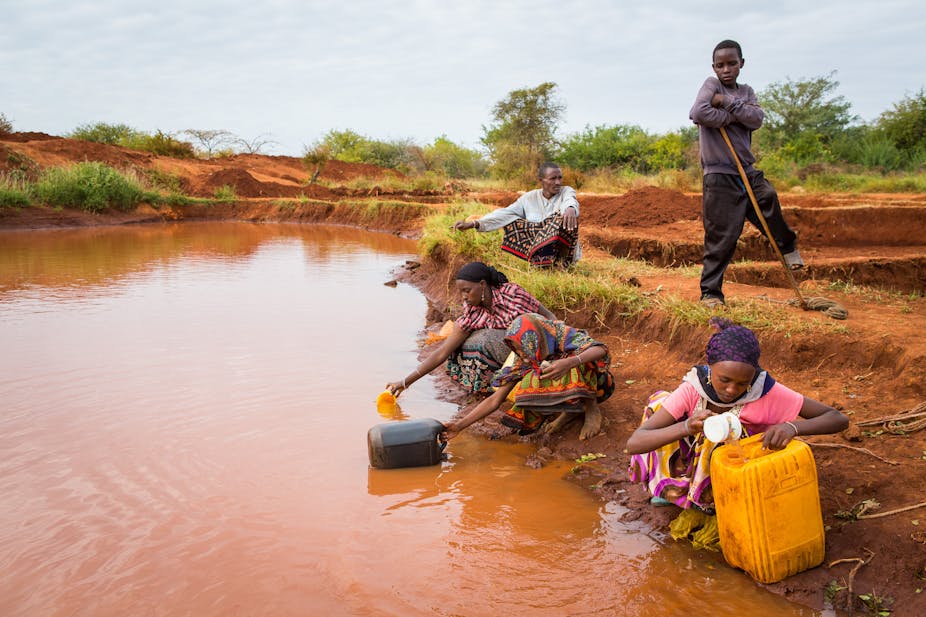For rural communities in the highlands of eastern Africa, water for domestic use is not piped. They have to collect, or use it from springs or rivers and it’s accessible to anyone. Increasingly, highland communities in Tanzania and Ethiopia face challenges when it comes to water quantity and quality.
Poor agricultural practices, deforestation and land clearing have led to soil erosion and excessive rainfall runoff which means underground water reservoirs are not recharged. Springs, once surrounded by trees and other vegetation, have dried out after land was cleared due to rising populations.
The water’s quality is also compromised, due to cultivation, the use of pesticides, household waste and clothes washing. This often leads to high incidences of waterborne diseases.
Declining water quantity and quality means people have to travel further to find good water sources – wasting time and energy.
This issue can’t be solved by individual households and weak enforcement of bylaws, due to corruption and weak leadership, mean it’s not being managed by the state either.
As part of the African highlands initiative, we carried out projects in three areas of Ethiopia and Tanzania to see if collective action – carried out by groups of people working together toward common goals – could work. These projects aimed to restore water resources and construct water points to give communities a clean water supply. In the past, households worked together, but these traditions have broken down over the years.
Two years later, the projects have been a success and there is increased water supply near homesteads. This has greatly saved time and improved the health of the communities.
Creating a strategy
Three areas, two in Ethiopia (Galesa and Gununo) and one in Tanzania (Baga) were selected for water source rehabilitation. This affected over 10,000 people in Tanzania alone. These areas had high population densities and were showing signs of water stress like decreasing crop and livestock production, fragmentation of land to small plots and increasing numbers of rural poor.
Research teams analysed historical trends – for instance how water quality has changed over time – using simple indicators like the time it takes to collect water, physical appearance and presence of pollutants in water.
A variety of farmers were then selected for interviews and they were asked about why the water sources had deteriorated and how they think the trend could be reversed.
For the three areas, a team of researchers and development workers came up with a strategy. We then implemented these same steps for all the areas:
Created awareness on the situation and emphasised the need for collective action
Set up water user committees – entrusted with the management of the water sources – to oversee the implementation of agreed plans
Identified and consulted with different stakeholder groups. Each was allocated a role
Developed by-laws with the participation of all stakeholders, and got them validated by communities to validates
Developed the skills of water committees and local leaders on water source management
Implemented agreed tasks
Took part in monitoring and evaluating targets
As much as possible, local materials and local artisans were used. For instance, local communities contributed labour, collecting stones and sand. They also managed the land around water sources to minimise the effect of contamination from soil erosion by planting water-friendly trees or vegetation around springs.
There were challenges. We had to convince donors to support domestic water supply because they believe it should be the role of a government ministry. Another challenge was that there were incidents where crops would get destroyed when people went through farms to collect water.
But these were overcome and the collective action approach was successful.
The results
Five years later about 84% of farmers confirmed that time for fetching water had gone down. And 82.9% responded that the prevalence of waterborne diseases had gone down.
At the Baga site in Tanzania, communities said that their time collecting water went down from an average of five hours to five minutes per day. During dry seasons women and children used to have to walk huge distances.
The number of patients treated for ailments related to unclean water also went down, from 77 in 2006 to 22 in 2007.
The collective action approach worked because the management structure was solid and the community were involved in enforcing the bylaws. For instance, if someone is destroying a water source, community members would take them to the authorities.
Collective action also increased confidence and trust among community members so they are more willing to interact to address a common problem.

